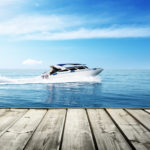Being familiar with and, above all, using sailing boat and sailing vocabulary well means dedicating yourself a little more to your role as a recreational sailor. It seems obvious that sailors who race are familiar with this vocabulary. They know every part of their yacht, what it does and its name.
Sometimes it is not so easy for the “young sailor” to learn all the right terms that go with the definitions and to use them quickly while sailing. Yet it is vital.
Sailor vocabulary compared to everyone’s vocabulary
Be careful, never use the word “rope”! The right term is “rigging”, rigging also being regularly referred to as “lines”. Similarly, on board a sailing boat, the left becomes port and the right starboard, while the front is the bow and the rear the stern.
As you can see, you can’t really get by if you don’t know a few basic terms.
Some words have an unusual name or different meaning to their “usual” one:
- cabestan: winch body,
- painter: chain or rigging,
- preventer: lines attached to the two lower ends of the spinnaker,
- sheet: line (adjustment of the angle of a sail in relation to the wind),
- mast head: upper end of the mast (top),
- topmast: top of the mast receiving guylines and stays,
But some parts have the same name, use and definition, whether they work on a sailing boat or are useful in other circumstances.
For example on a sailing boat,
- a shackle remains a part formed of an U-shaped, lyre-shaped, or round iron closed by a movable axis such as a bolt or a shackle, and
- an eyelet on the main sail is the same as that on a shower curtain: it is a ring inserted into the fabric and offers the best possible glide.
We have therefore focused on terms found in a yacht’s vocabulary.
How is the vocabulary of a sailing boat organised?
More than anything, for a boat to be called a “sailing boat”, its propulsion power must be mainly the wind (sailing power) and two elements are essential for this: the mast and the sail.
The mast and sail need to be precisely adjusted, and are set up with a multitude of lines for furling, bearing away, reefing, or simply hoisting the sail up its mast. These lines are themselves fixed, oriented, slid, wound, guided, etc. thanks to there being many parts, al coming under the name of rigging chandlery, the hardware for a boat.
Rigging chandlery vocabulary for a sailing boat
- Jammer: provides two functions by allowing line tension to be gradually blocked then released while maintaining the winch settings.
- Capstan: the ancestor of the winch, it is identical to the winch (manual or motorised).
- Chainplate: a metal part (usually), fixed to the vessel deck or hull. The wires holding the mast are attached to it.
- Deadeye: hoists made of two round, combined pieces of hardwood with a groove; usually drilled with three holes.
- Sheet return carriage: pulley on rail; modifies the position of sheets during manoeuvres.
- Fairlead: an integral part of the stem to pass the moorings.
- Slider: small piece of metal (plastic) sewn onto the large sail, sliding into the groove of the mast.
- Turnbuckle: set of metal parts used to tension a wire (stay, guy, backstay, etc.).
Vocabulary related to the sail
The sail seems to be just a piece of canvas, but there’s a lot of vocabulary that goes with it and it is better to take it on board before going sailing at all (at least partly).
The three sides of a triangular sail are named:
- luff: side fixed to the mast when the sail is the main sail and fixed to a stay for the front sails such as the jib, forestay sail or storm jib (storm sail),
- foot: side fixed to the boom,
- leech: free side of the sail.
Logically, the sail shows three angles and sailing vocabulary refers to them as “points”:
- head of the sail: at the intersection of the luff and the leech. Halyard attachment point
(halyard: line used to lift or lower the sail),
- tack: at the intersection of the luff and the foot, it holds the sail connected to the end of the boom and the bottom of the mast,
(tack: side of the boat via which the wind arrives, the sailing boat is “port tack” or “starboard tack“),
- clew: at the intersection of the leech and the foot. An attachment point for the sheet, it makes the sail connected to the second end of the boom.
The rigging of a sailing boat, defined as all masts, sails and stays, is divided into two parts: the standing rigging or standing manoeuvres and the running rigging or running manoeuvres.
Vocabulary that goes with a sailing boat rigging
Standing rigging (Standing manoeuvres): the fixed parts of the rigging of a sailing boat, i.e. all wires and lines supporting the mast on which no action is carried out during navigation (rigging, stays, backstay, lower shrouds, cap shrouds, etc.).
- Crosstrees: a spar perpendicular to the mast that spreads the tie rods to optimise the holding angle and reduce compression on the mast.
All of the small crosstrees, gathered at the stay attachment point and inverted from their usual use, are referred to as the jumper stay.
- Lower shroud: a wire used to hold the mast at the crosstrees.
- Running backstay: holds the mast at the back.
The running backstays are in pairs: the running backstay in the wind is hauled in, while the one under the wind is shocked.
- Inner forestay: a steel wire reinforcing the mast from mid-height to the stem. It is also used to set up the staysail.
- Stay: supports the mast at the front.
- Backstay: a wire (single or double) to support the mast at the back, from the top of the mast.
Running rigging (running manoeuvres): mobile lines for adjusting the sails (halyards, preventer, sheets, tacks, topping lift, boom vang, etc.)
- Topping lift: a line that starts at the top of a mast and supports the boom (or yard) in its resting position.
- Boom: a horizontal spar articulated in the axis.
- Gasket: a fine line, used to modify the surface of the main sail.
- Boom vang: hoist usually attached to the foot of the mast and pulling the boom downwards,.
- Peak (gaff rig): a vertically lifted spar that finishes on the mast side, with a jaw or a toggle fork (two-toothed fork-shaped joint between the mast and a spar, boom or yard).
- Outrigger: a spar that spreads the sail.
- Yard: part that is articulated and attached to the mast or supported by the mast that usually carries a sail (boom of the main sail or peak (gaff rig) of a fore-and-aft rig).
- Wishbone: a doubled spar that passes through each side of a sail, stretching it longitudinally. It serves as a boom on windsurfing boards and small sailing boats.
The vocabulary that goes with sailing manoeuvres
Many manoeuvres are possible on board a sailing boat, and a few are a must.
A
Bear away: to steer the boat’s axis away from the wind (opposite: luff).
Haul down: quickly lower a sail/yard.
Reefing: to temporarily reduce the surface area of the sail.
B
Sheet in: pull on a line (sheet) to stretch the sail and be able to counter more wind resistance. The thrust is developed and the sailing boat accelerates its course (opposite: lease off).
C
Lease off: relax, give slack to a running manoeuvre (sheet) ((opposite: sheet in).
D
Unfurl: deploy the sails.
E
Sling: place a sling on a load.
Gybe: change direction/tack.
Hank on (to): attach a jib to a lifeline or a stay using rings or hooks.
Bend a sail to its yard: attach the sails to the yards.
Harden up: Stretch one line firmly.
F
Furl: fold a sail around a yard/boom.
Pay out: to ease, or slacken a line or chain.
G
Rig: install rigging.
H
Hoist: raise a sail.
L
Ease: release or slacken a rope.
Luffing: get closer to the wind.
Tacking: to change course by turning a boat’s head into and through the wind and fill the sails with the wind from one side of the boat to the other to beat. This manoeuvre allows the sailing boat to move forward against the wind.
M
Hove to: immobilise the sailing boat facing the wind: lease off the main sail, sheet in the opposite jib and lashing the helm to leeward.
P
Reefing: reduce the surface area of a sail: partially haul down the sail to reduce the effective surface area.
R
Luff up: place a sail parallel to the wind, so that it does not fill up.
V
Tack: change direction/tack. The sailing boat crosses the wind axis by receiving the wind from the bow (front).
Vocabulary associated with a sailing boat’s point of sail
In sailing, the point of sail is the angle that the sailing heading forms with the wind axis.
If the sailing vessel changes direction to get closer to the wind axis, it sails “beating”, whereas if it moves away from it, it sails “reaching”.
What are these main sectors?
- “Headwind” (angle < 45 degrees): this sailing sector does not (necessarily) correspond to a direction; the sailing boat sailing into the wind must beat to move forward.
- “Close-hauled” (angle between 45 and 65 degrees): the closest to the wind sailing boat can be. The sails are hauled in (to the maximum) and the sailing boat lists.
- “Close reach” (angle about 60 degrees): is a more comfortable point of sail than close-hauled. The sails knock against each other, the sailing boat lists less.
- “Beam reach” (angle = 90 degrees): the most comfortable point of sail, the sailing boat is fast, it enters the points of sail that propel it forward. The gennaker (or spinnaker) is unfurled.
- The “reach” or “broad reach” (angle between 65 and 170 degrees): the true wind comes from behind, but not directly behind. The propelling sails are very efficient.
- “Running downwind”: the sailing boat moves as fast as possible with the wind speed.
That’s a fair amount to learn for the vocabulary of a sailing boat. However, you don’t have to learn everything before you start sailing!




